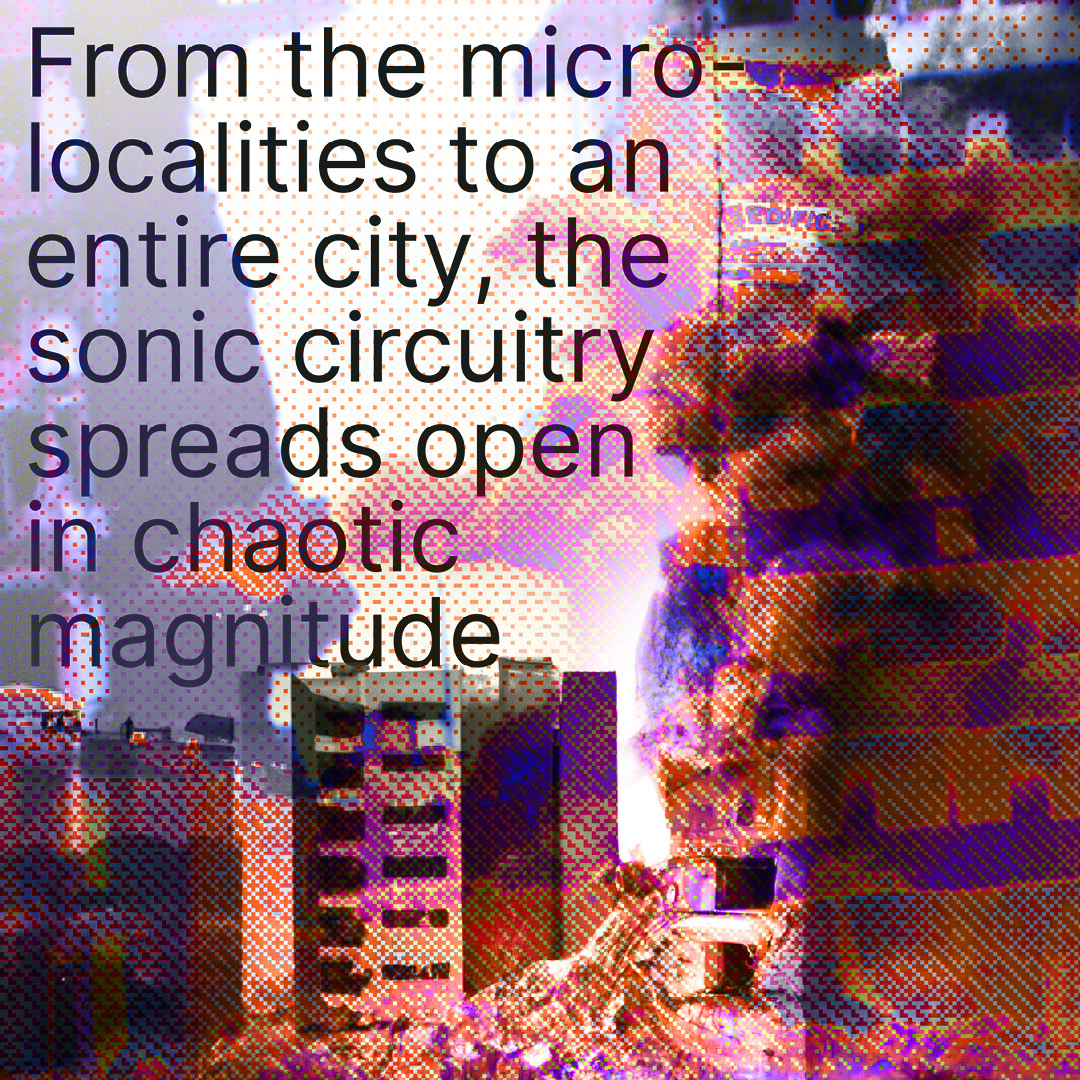Night and Silence
A sonic transmission by Ruhail Qaisar, an artist and producer who dabbles in field recordings, electronics, drones, noise music, and other experiments with sound. In this experimental composition and accompanying note, Ruhail (de)constructs a soundscape of sonic emissions from New Delhi, India, evoking the all-too-familiar feeling of being entrenched in a simulatory chaos of coalescing and collapsing.
Cities at times seem to be the least conducive spaces for ideas and inspiration. The only advantage that presides over the alternatives present to me is primarily either logistical or access-based. Yet, so far in my practice, I have always had the region of Ladakh1 to go back to, and its bare hinterlands have kept me drawn and fulfilled with vernacular conjunctions that I can always expand upon.
At a time when the neoliberalization of the whole country was already in full motion, I was growing up in the border state of Ladakh and imagining New Delhi as a child. There was evidently an inferiority that most people from lower middle-class families lived with. While the television mediascape and its desire machine were churning out new products every day, due to being in a remote corner of Jammu and Kashmir, these products would usually take either a year or longer to appear in the local markets, whether it be candies, toys, music, or cinema. Even in the unconscious mind, as children, we felt that our land was inferior. Only in a city like New Delhi would one have access to a McDonald’s Happy Meal, an actual pizza from Pizza Hut, non-bootleg Funskool action figures, Mattel Barbies, G.I.Joes, the works.
Fast forward to my teenage years, when Ladakh had its socio-economic lag reduced to two or at the most three months in terms of access to new products. As cable TV and dial-up internet had already made their way there post-2000s, my tryst with punk and metal music began slowly through neighbors who were studying in the mainland. Now, with a new desire machine in place again, I found no traces of that in Ladakh. While I got three-month-old issues of RSJ (Rock Street Journal) magazines from a local stationery shop, I slowly became aware that there was a growing scene in the mainland and that I needed to make my way there. Since I didn’t have any financial means to do that, the only guise or subterfuge that would work was education, as Ladakh until then still didn’t have enough schools that went beyond the 10th grade.
By the time I arrived in Delhi, which was in 2012, heavy guitar music was not en-vogue anymore – all the clubs were either playing indie bands or dance-based electronic acts. I saw that all the local bands had the privilege of access to studio time as well as expensive equipment, with an emphasis on expensive. I had recently discovered that these imports are levied with heavy custom taxes, and hence their prices become two-fold steeper.
Regardless of these obstacles, I formed numerous bands and performed with them around the city, never compromising on the performance and the delivery no matter how janky our equipment or how miserable the artist fee was. Eventually, market logistics again trumped passion as promoters and venues started diminishing and dance music took over. Nobody wanted to hire a band and pay fees to five people when one person with a USB stick could sell out a bar. After this, I lost the will to see any potential in forming a band in Delhi or even imagining a strong community or a scene here. I lowered my expectations and started working by myself.
So my relationship with Delhi has many bitter seams to be traced. What I still find appalling in my ten years of being here is the extent of the chaos and the impinging sense of being overstimulated as soon as you exit your house – the marriages, the demolitions and constructions, the traffic jams that never cease but rather accelerate, the only breather sadly being the pandemic.
It certainly seems at times that one cannot ever escape a new construction project in the neighborhood. Irrespective of where anyone moves, abrasive swirls of drilling, the thump of hammering, loud exchanges of instructions, blaring automobile horns, late-night pick-up trucks dumping pebbles and cement—all of it finds a way to seep into a dwelling with no regard to time.
The principles at play in the experimental composition «Night and Silence» almost draw a parallel to David Dunn’s track «Chaos & the Emergent Mind of the Pond», where simultaneous cycles work out of phase. Like observing the global behavior of hyperchaotic analog circuits, whether from a small perspective of its myriad micro-localities or as an entire city, the sonic circuitry rather spreads open in chaotic magnitude. This is what listening to the city often feels like – a perturbation to daily existence in the form of overstimulating spectacles, dust, smog, river foam, cockroaches, Teflon, asbestos, traffic, waterlogging, and dengue singing in hyperchaotic unison.
- 1. Ladakh is a high-altitude plateau region extending from the Himalayan to the Kunlun mountain ranges. In 1947, with the end of British rule and the Partition of India, Ladakh came under Indian administrative control as a region in the state of Jammu and Kashmir. In 2019, after the central government abrogated Article 370 of the Indian constitution that gave special status to Jammu and Kashmir, Ladakh was separated from the state of Jammu and Kashmir and turned into a federally governed territory.
This composition is part of the virtual exhibition «Norient City Sounds: Delhi», curated and edited by Suvani Suri.
Project Assistance: Geetanjali Kalta
Graphics/Visual Design: Upendra Vaddadi, Neelansh Mittra
Audio Production: Abhishek Mathur
Video Production: Ammar
Biography
Shop

Published on September 29, 2023
Last updated on February 21, 2024
Topics
About the micropolitical qualities of sound as a non-conscious experience of intensity.
A form of attachement beyond categories like home or nation but to people, feelings, or sounds across the globe.
Why do people in Karachi yell rather than talk and how does the sound of Dakar or Luanda affect music production?
How do acoustic environments affect human life? In which way can a city entail sounds of repression?
Special
Snap





